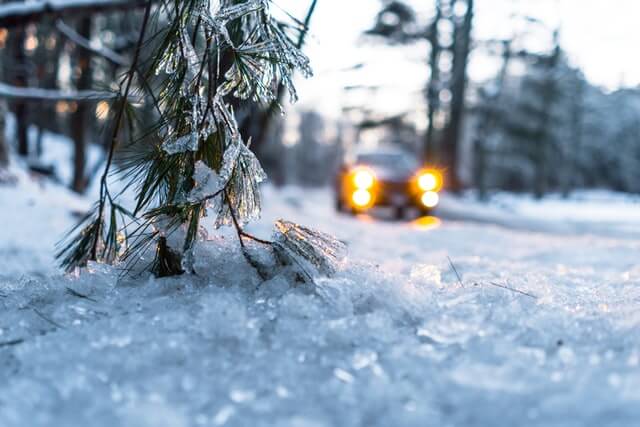Last Updated on November 12, 2023 by Rose Morah
If you are wondering what to expect when driving a Nissan Leaf during winter, this article has covered Leaf’s performance in winter conditions as well as the expected range.
This is what we are going to cover:
- Nissan Leaf’s performance in snow.
- Nissan Leaf range during winter.
Nissan Leaf’s Performance when driving in snow
Based on our experiences and feedback from other Nissan Leaf owners, Nissan Leaf handles quite well when driving in snow.
Based on an online survey of Nissan Leaf Owners conducted to determine Leaf’s performance in snow, 80% of the respondents said they felt safe driving the Leaf in heavy snow while 50% said that it performed better on snow than expected.
Additionally, to see how the Nissan Leaf would perform when driven on a slippery road, we did a brake and stability control test on our Nissan Leaf.
We did this on winter tires, which is what’s recommended, and the Nissan leaf passed the brake and stability test.
See the Best Tires For Nissan Leaf.
What makes Nissan Leaf’s performance on snow better?
The following are the reasons why Nissan Leaf performs well in snow/winter conditions:
- The weight of the vehicle
When driving a Nissan Leaf on snow, you can almost feel its weight pushing you through the snow.
This is because it has a decent ground clearance and is heavy. The vehicle’s weight is what manages to get the tires down into the snow. You are, therefore, able to get better handling when driving on snow.
Additionally, since the Nissan Leaf’s weight is centered between the wheels and the weight is down low, this makes it harder for the vehicle to roll over.
- Eco mode and ePedal
When the Eco Mode and ePedal are activated, the handling gets better when driving the Nissan Leaf on snow.
Eco mode makes the vehicle push harder while getting the same amount of power.
On the other hand, ePedal makes it easy to control the car when driving on snow because it applies a good amount of control over the tire rotation.
- Tires
Even if you’re getting good traction when driving your Nissan Leaf on snow, you still need to get winter tires for better performance.
You will notice a huge difference in performance when driving your Nissan Leaf on snow when you have winter tires installed.
For instance, many Nissan Leaf owners report getting a better experience when driving on heavy snow (that is about 10 inches) after installing the Michelin X-Ice winter tires.
A good set of tires will also give you better braking when driving the Leaf on snow.
You may also like:
5 Nissan Leaf Tips For New Owners.
How To Check Nissan Leaf Battery Health.
Nissan Leaf range during winter
You should expect a range drop on your Nissan Leaf during winter. This is not only experienced in Nissan Leaf, it is a common thing in most EVs in the market.
The range drops highly depends on the temperature. For example, you will notice a huge difference in range drops when the temperatures are 25F vs 0F or even colder.
From the survey, most Nissan Leaf owners with the older models experience 30% to 50% of range loss during winter, depending on the temperature.
Those that had newer models reported to have experienced 15% to 40% of range loss during their winter driving, depending on the temperature.
NOTE: Range loss on Nissan Leaf will also largely depend on the Model year (trim) and temperature.
Newer Nissan Leaf Models perform better in winter conditions compared to older Nissan Leafs.
See the Nissan Leaf Model Comparison.
You may also like: How Is VW ID.4 in The Snow? (AWD vs. RWD ID.4)
Reasons why Nissan Leaf owners experience range loss during the winter season
- Increased rolling resistance
When driving Nissan Leaf during winter, the snow tends to increase the rolling resistance, which affects the vehicle’s range.
An increase in rolling resistance is mostly caused by the cold roads and tires which tend to be harder.
This explains why driving an EV on snow and ice increases energy loss.
Read This Before Buying A Low Rolling Resistance Tire.
- Battery capacity
Cold temperatures tend to temporarily reduce the Nissan Leaf’s battery capacity. This is quite common even in other EVs.
Additionally, you will experience slow charging when you are charging your Nissan Leaf during colder seasons.
| PRO-TIP Use Leaf spy when driving during colder temperatures to get the realistic battery charge that is remaining to get you to your destination. |
See How To Use Leaf Spy Lite and Pro on Nissan Leaf (A Complete Guide).
- Heating the cabin
In the survey, most Nissan leaf owners also reported having experienced ~5-10% range loss when heating the cabin, on about 30 minutes drives.
If you want to fast charge your Nissan Leaf when it’s extremely cold, you need to turn off the heater. This will get you good charging speeds.
| TIP -If you are worried about range loss on your Nissan Leaf when driving during winter, you can wear warmer clothes and use blankets to avoid using the heater the whole time when driving. -Alternative, you can heat the seats and the steering wheel only instead of heating the whole cabin. |
- Snow tires
Snow tires offer a much better handling performance when driving in snow. However, you will have to sacrifice some range in return.
Most EV owners experience slight range loss after installing winter tires. This is because most snow tires in the market tend to eat up more energy thus affecting your range.




